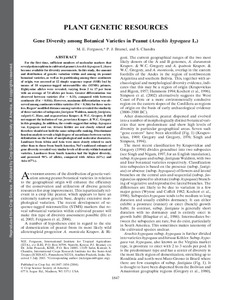| dc.contributor.author | Ferguson, M. |
| dc.contributor.author | Bramel, P.J. |
| dc.contributor.author | Chandra, S. |
| dc.date.accessioned | 2019-12-04T11:23:57Z |
| dc.date.available | 2019-12-04T11:23:57Z |
| dc.date.issued | 2004 |
| dc.identifier.citation | Ferguson, M.E., Bramel, P.J. & Chandra, S. (2004). Gene diversity among botanical varieties in peanut (Arachis hypogaea L.). Crop Science, 44(5), 1847-1854. |
| dc.identifier.issn | 0011-183X |
| dc.identifier.uri | https://hdl.handle.net/20.500.12478/4223 |
| dc.description.abstract | For the first time, sufficient numbers of molecular markers that reveal polymorphism in cultivated peanut (Arachis hypogaea L.) have become available for diversity assessments. In this study, the amount and distribution of genetic variation within and among six peanut botanical varieties, as well as its partitioning among three continents of origin, was assessed at 12 simple sequence repeat (SSR) loci by means of 10 sequence-tagged microsatellite site (STMS) primers. Eighty-nine alleles were revealed, varying from 2 to 17 per locus with an average of 7.4 alleles per locus. Greater differentiation was observed between varieties (Fst = 0.33), compared with between continents (Fst = 0.016). However, maximum differentiation was observed among continents within varieties (Fst = 0.366) for three varieties. Rogers' modified distance among varieties revealed the similarity of three varieties of subspecies fastigiata Waldron, namely fastigiata, vulgaris C. Harz, and aequatoriana Krapov. & W.C. Gregory. It did not support the inclusion of var. peruviana Krapov. & W.C. Gregory in this grouping. In addition, the results suggest that subsp. hypogaea var. hypogaea and var. hirsuta Köhler are not closely related and therefore should not hold the same subspecific ranking. Discriminant function analysis reveals a high degree of accordance between variety delimitation on the basis of morphological and molecular characters. Landraces from Africa and Asia were more closely related to each other than to those from South America. Nei's unbiased estimate of gene diversity revealed very similar levels of diversity within botanical varieties. Landraces from South America had the highest diversity, and possessed 90% of alleles, compared with Africa (63%) and Asia (67%). |
| dc.description.sponsorship | World Bank |
| dc.description.sponsorship | Common Fund for Commodities |
| dc.language.iso | en |
| dc.subject | Gene |
| dc.subject | Peanut |
| dc.subject | Arachis Hypogaea |
| dc.title | Gene diversity among botanical varieties in peanut (Arachis hypogaea L.) |
| dc.type | Journal Article |
| dc.type | Journal Article |
| dc.description.version | Peer Review |
| cg.contributor.crp | Grain Legumes |
| cg.contributor.affiliation | International Institute of Tropical Agriculture |
| cg.contributor.affiliation | International Crops Research Institute for the Semi-Arid Tropics |
| cg.coverage.region | Acp |
| cg.coverage.region | Asia |
| cg.coverage.region | Africa |
| cg.coverage.region | South America |
| cg.coverage.region | South Asia |
| cg.coverage.region | West Africa |
| cg.coverage.region | Central Africa |
| cg.coverage.country | Bolivia |
| cg.coverage.country | Ecuador |
| cg.coverage.country | Paraguay |
| cg.coverage.country | Peru |
| cg.coverage.country | India |
| cg.coverage.country | Nepal |
| cg.coverage.country | China |
| cg.coverage.country | Burkina Faso |
| cg.coverage.country | Nigeria |
| cg.coverage.country | Chad |
| cg.isijournal | ISI Journal |
| cg.authorship.types | CGIAR multi-centre |
| cg.accessibilitystatus | Limited Access |
| local.dspaceid | 99789 |
| cg.identifier.doi | https://doi.org/10.2135/cropsci2004.1847 |

